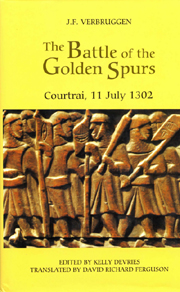 The Battle of the Golden Spurs (Courtrai, 11 July 1302)
The Battle of the Golden Spurs (Courtrai, 11 July 1302) Book contents
- Frontmatter
- Contents
- List of Illustrations
- General Editor's Preface
- Editor's Introduction to the 2002 edition
- Foreword to the 1952 edition
- Acknowledgements (to the 1952 edition)
- Preface: ‘An almost impossible event …’
- Introduction
- Part One Historiography and the Study of the Sources
- Part Two Historical Overview of the 1302 Campaign
- General Conclusion
- Bibliography
- Index
General Editor's Preface
Published online by Cambridge University Press: 12 September 2012
- Frontmatter
- Contents
- List of Illustrations
- General Editor's Preface
- Editor's Introduction to the 2002 edition
- Foreword to the 1952 edition
- Acknowledgements (to the 1952 edition)
- Preface: ‘An almost impossible event …’
- Introduction
- Part One Historiography and the Study of the Sources
- Part Two Historical Overview of the 1302 Campaign
- General Conclusion
- Bibliography
- Index
Summary
‘The Flemings stand there as hopelessly determined men.’
Giovanni Vilani, Historie fiorentine (cited p. 230)Anniversaries obviously matter. Exactly seven hundred years ago, Flemish townsmen crushed the chivalry of their French overlord in a dramatic and bloody encounter. Precisely half a century has passed since the best military historian of his era published this study in his native Flemish. J.F. Verbruggen's The Art of Warfare in Western Europe during the Middle Ages, published in English translation in 1997, the third book in this series, captures the broad sweep of his subject, while this present volume is a detailed case study. As my old tutor, R. Allen Brown, used to say, ‘All history is local history’, and Verbruggen's analysis supports this dictum perfectly.
For, to really understand a battle, it is essential to have a clear and accurate understanding of the ground over which it was fought. The author's close investigation of this matter enables him to draw conclusions about why and how the opposing commanders drew up their forces in the way that they did. Flowing from that is the issue of the tactics used by both sides – and flowing is an appropriate word because of the significance of the water-filled ditches and marshy areas which provided the Flemish foot-soldiers with a strong position to defend. But, contrary to frequently over-simplified views of the battle, the French did not charge heedlessly into a trap.
- Type
- Chapter
- Information
- The Battle of the Golden Spurs (Courtrai, 11 July 1302)A Contribution to the History of Flanders' War of Liberation, 1297–1305, pp. ix - xPublisher: Boydell & BrewerPrint publication year: 2001


